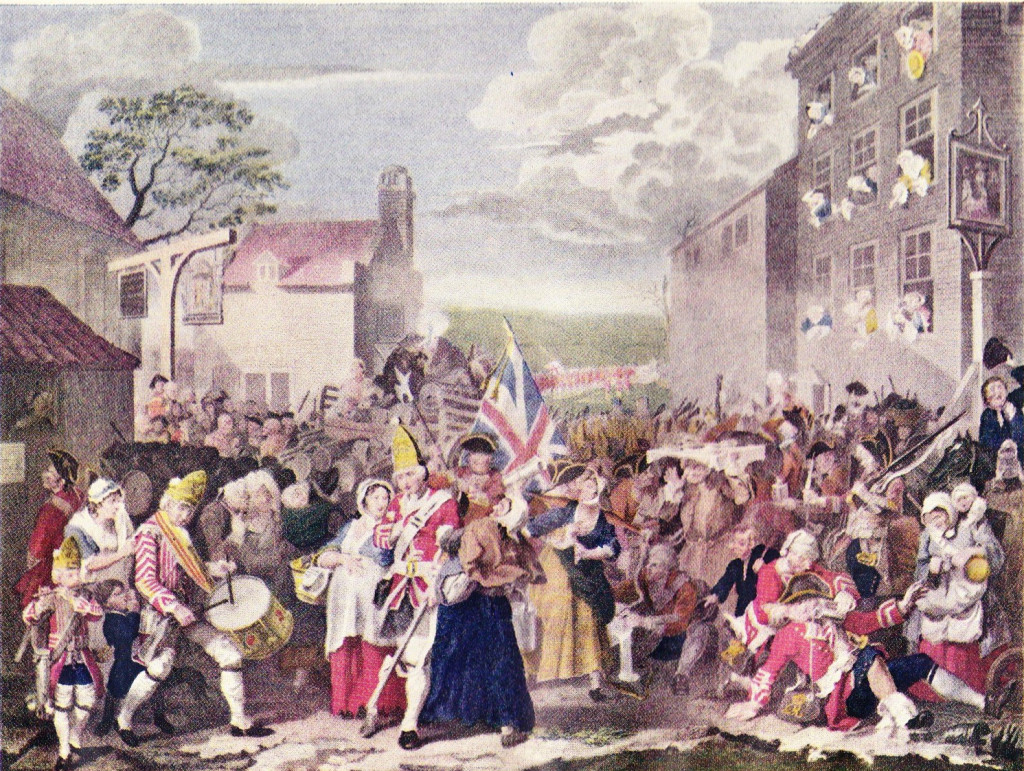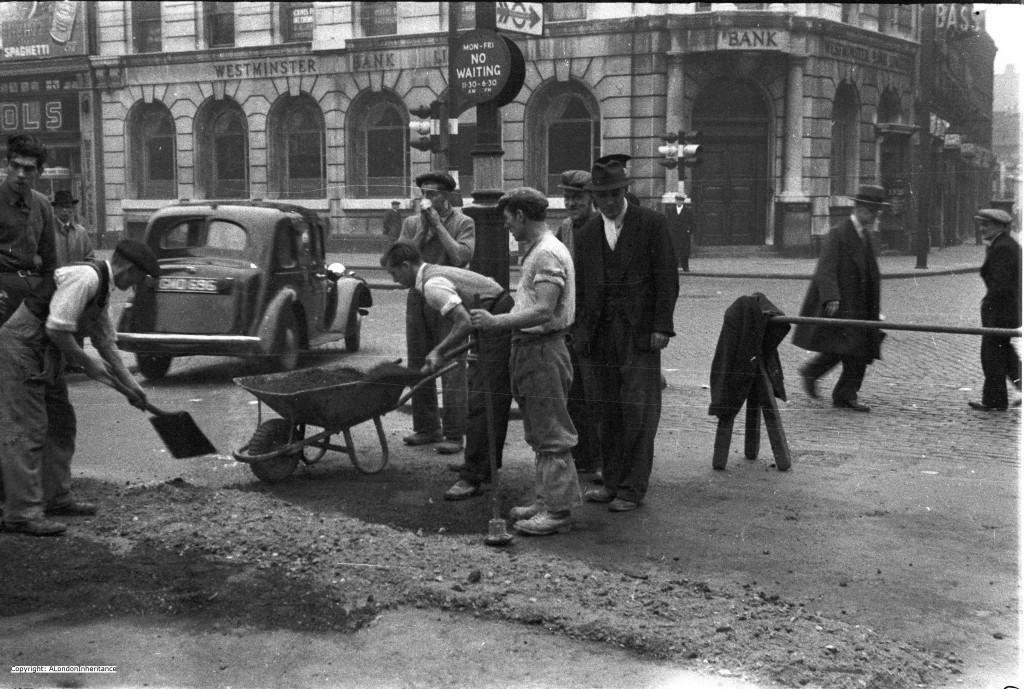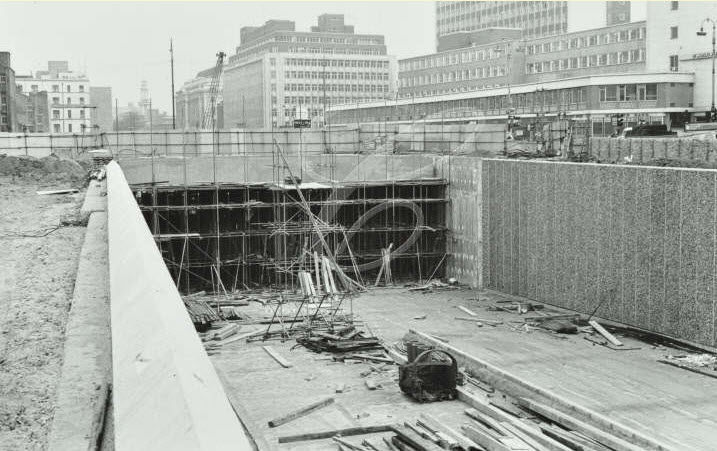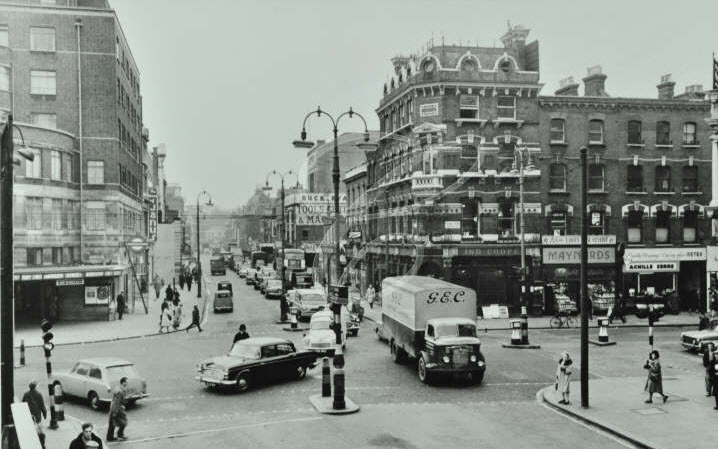There are some photos from my father’s collection that I was unsure of whether I could find the location where the photo was taken. This week’s post is a typical example of this type of photo, but also how such a simple photo leads into further investigation of the area where the photo was taken. This is what I wanted to get out of this journey, find the location of where all my father’s photos were taken and increase my knowledge of the history of London.
Two very similar photos taken in the late 1940s show a group of men working on the road at a road junction, with a Bank on the corner behind them.
There was nothing really to identify the location, however on closer examination of the Bank, there is the street name of Hampstead Road. The name on the sign on the right of the Bank cannot be identified so I could not work out the road junction. The angle and the distance does not allow a name to be resolved. So I knew this was in Hampstead Road on a street corner, but where? I have walked Hampstead Road before and could find no location that fits these photos.
I have a number of sources to search, both written and online to try to find locations and I eventually found the location for this one following a search on the English Heritage website searching for a Bank in Hampstead Road. This resulted in a photo of the same bank, identifying the location as on the corner of Hampstead Road and Euston Road, so now I had the location with the photo being taken outside Warren Street underground station looking across the Euston Road to the Bank on the opposite corner.
The junction of Euston Road, Hampstead Road and Tottenham Court Road has changed dramatically over the years since this photo was taken. The Euston Road has been considerably widened with the Euston Underpass being constructed to take traffic along the Euston Road under the junction of Tottenham Court Road and Hampstead Road.
Working along the Euston Road to Great Portland Place underground station shows how the road has been widened at this junction with the road at Great Portland Place being about the original width.
There are still many original building on the south side of Euston Road with Warren Street underground station being one of these that has not changed, therefore the south side marks the original alignment of Euston Road. The north side has all been redeveloped with Euston Tower and the more recent Regent’s Place office buildings. My estimation of where the bank was located is therefore half way across the new road, just over the Euston Underpass.
There was one point that worried me in confirming the location of this photo, there is an Underground sign pointing east along Euston Road, I would have assumed that if this was outside Warren Street it would be pointing to the station, however a quick check confirmed that in the direction of the sign, a short walk along Euston Road is Euston Square underground station, so this sign was directing travellers emerging from the Northern line at Warren Street to the Circle, Hammersmith and Metropolitan lines at Euston Square.
The following is my 2014 photo from roughly the same position outside Warren Street underground station as the original.
Very hard to be precise as there has been so much change since the original, and I suspect I should have been more on the current edge of Euston Road slightly to the left. If I have worked out the original road widths correctly then the corner of the Bank in the original photo is roughly where the white truck is in the 2014 photo.
Despite the appearance of this road junction and the surrounding areas, as with anywhere in London there is a considerable amount of hidden history to be discovered.
The following map is from the 1940 edition of Bartholomew’s Reference Atlas of Greater London with the red oval covering the area of today’s post. The junction of Tottenham Court Road, Hampstead Road and Euston Road is under the “J” in the centre of the oval. Warren Street station can just be seen and the photo was taken outside looking diagonally across Euston Road.
If we cross the Euston Road from Warren Street to the north side we find Euston Tower and the Regent’s Place development. This has completely obliterated Eden Street, Seaton Place, Fitzroy Place, indeed this whole area bounded by Drummond Street and Osnaburgh Street.
Eden Place was probably where the front of Euston Tower is now located and was lost in the widening of Euston Road and the construction of the underpass. Seaton Place was probably at the rear of Euston Tower, this is now a pedestrian walkway between Euston Tower and the other office blocks of Regent’s Place which for some reason is called Brock Street. No idea why the original name could not have been retained.
It was on this corner of Hampstead Road where the Adam and Eve Tavern was located. The location now is probably exactly where the underpass dives under the Hampstead Road, Tottenham Court Road junction. This was built on the original site of the Tottenham Court from which Tottenham Court Road takes its name. The manor was converted to the original Adam and Eve somewhere around 1645. Up until the later part of the 18th century the tavern and extensive gardens were very popular with Londoners. In the road outside the Adam and Eve, Hogarth set the scene for his “March to Finchley” where a military camp had been set-up and the picture shows the disorderly Guards in true Hogarth style on their way to the Finchley Camp as part of the journey to Scotland to meet the Jacobite Pretender (Charles Stuart).
The March to Finchley is shown below:
The Hogarth picture shows two Taverns with the Adam and Eve on the left and the Old Kings Head is on the right. Strange to think that the Euston Underpass is now running left to right across this picture. The King’s Head was demolished in 1906 to make way for the widening of the Hampstead Road. The very narrow road width of the junction at this point had long been a problem as the King’s Head jutted out into the thoroughfare and calls had been made to address this from the start of the nineteenth century.
Also, when the Adam and Eve and Kings Head were at the peak of their popularity, much of this area was countrified and to demonstrate the rural nature of the area, the following advert appeared in The Postman for December 30th 1708 of a house to be let:
“at Tottenham Court, near St. Gile’s and within less than a mile of London, a very good Farm House, with outhouses and above seventy acres of extraordinary good pastures and meadows with all conveniences for a cowman, are, to be let, together or in parcels, and there is dung ready to lay in”
I took the following photo on the east side of Tottenham Court Road looking over towards Euston Tower and Regent’s Place. The Adam and Eve Tavern was roughly where the red traffic lights are now located with Eden Street just in front of Euston Tower.
The following photo is the second of the same scene. It is fascinating to compare working conditions of the late 1940s with those of today. Not a single high visibility jacket or traffic cone in sight.
I have recently received some fantastic photos of the Euston Road, Hampstead Road junction and the building of the underpass from John Cinnamond. They show the junction before the widening of the Euston Road and the building of the Underpass.
The first photo, taken in 1961, is looking east along Euston Road. The bank on the left of the photo is the same as the one in my father’s photo, however this now shows the full view of the road.
The next photo, also taken in 1961 is looking west along Euston Road. Warren Street Underground Station is on the left and this is basically the same today, however the very significant change is to the right of the photo. The pub on the corner is the Adam and Eve. All the buildings on the right of this photo were pulled down in order to make way for the widening of the Euston Road and the Euston Underpass. Where the buildings on the right, facing the camera stood, is now the underpass and a bridge over the underpass leading to the north side of Euston Road.
I have repeated one of my photos from earlier in the post. This is looking across to where the pub and the buildings running to the right in the photo above used to stand.
Now we come to the building of the Underpass. These photos were taken in 1966 and this is looking across to Warren Street Underground station, the curved building to the left of the photo. The pub and buildings in the early photos ran across to the right, where the hoarding can be seen, but have now been pulled down and the Underpass is being built.
And looking in an easterly direction, the Underpass is where the bank used to stand, which would have been roughly left of centre, slightly set back from where the Underpass goes under the road.
One final photo which again is from 1961 and is looking to the west. The lorry is from the company G.E.C. the engineering and electrical conglomerate that failed so spectacularly after trying to turn itself into an internet / communications business at the height of the dot-com bubble. Interesting not only how the urban landscape changes, but also the businesses operating in that landscape.
An amazing series of photos and I am very grateful to John for sending and letting me include in the post as they complete the story of how this road junction has changed so considerably.
So, one simple road junction in London, but as with most places across London, a fascinating history.
The sources I used to research this post are:
- London’s Old Latin Quarter by E. Beresford Chancellor published 1930
- London by George H. Cunningham published 1927
- Old & New London by Edward Walford published 1878
- Bartholomew’s Reference Atlas of Greater London published 1940












Wonderful research. I look forward to all your posts-
Thanks. I just find it so interesting the history behind this fascinating city.
Great post – always loved the Hogarth Picture (can be seen in the Foundling Museum) but I think you probably have the location of Tottenham Court Manor wrong. I know lots of texts do say that the Adam & Eve was based on the Tottenham Court Manor House – but I think it was on the other side of the road just to the south of Tolmers Square. See this source http://www.british-history.ac.uk/report.aspx?compid=65193 for more details.
Hi David, thanks for the comments and I suspect you are right regarding the location of Tottenham Court Manor. I did find many conflicting texts, but have been checking recently and agree with the probable location to the south of Tolmers Square.
The Old King’s Head was situated at 282 Euston Road and was apparently not demolished in 1906 but traded until at least 1921 but had been demolished by 1961: https://www.pubology.co.uk/pubs/8112.html
Slightly to the east was the Orange Tree at 234: https://pubshistory.com/LondonPubs/StPancras/OrangeTree.shtml
The Adam & Eve was immediately to the west of the Old Kings Head at 284-286, directly to the north of Warren Street station. Interestingly, its former address is now used by Euston Tower: https://www.pubology.co.uk/pubs/8000.html
It’s amazing how much Euston Road has changed over the years!
I have a couple of overhead shots of Euston Road from 1961. One looking East (showing the same bank still in business) – and one looking West showing the Adam and Eve pub. Get in touch if you’d like me to send them to you.
Hi John, agree it is amazing how much Euston Road has changed over the years, indeed much like the rest of London. Would really like to see the overhead shots of Euston Road.
Glad to have helped with the photos and many thanks in the first place to yourself for this website and to your father for taking for such fantastic photographs all those years ago……as well as a thanks to Google for getting me here in the first place during a search for ‘Old Camden Photos’
I like to think I embrace change and technology today in the same way as I did thirty years ago when I was a teenager (with Walkmans, CDs etc.) – let’s face it, none of us would be on here now if it wasn’t for technology….
But I can’t help but look at the pictures on this blog with a sense of ‘If it wasn’t broke, why fix it?’ frame of mind.
I’m either getting old before my time or I think I was born too late in life!
Very interesting post.l grew up in this area in the sixties. Just one point I did read that Stanhoope Street was originally called Brock Street hence the name of the new development.
A bit more information for you. You’ll do well to have a look on old-maps.co.uk for further mapping research.
It appears that on their 1851 scan of the area, Stanhope Street is called Mary Street in the north and Brook (or Brock) Street south of Charles Street, now Drummond Street. Mary and Brook/Brock became Stanhope Street some time between the 1851 and 1873 maps, when Stanhope Street was simply extended southwards by renaming. Charles Street became the extended western end of Drummond Street by renaming some time between the 1875 and 1895 maps.
As for your photo, the bank in question came into being some time between 1896 and 1916. On the 1896 1:2500 map, you can clearly see the jutting out into the Euston Road of the King’s Head pub that you mention. On the 1916 map, a fairly large part of that whole terrace including the King’s Head has been removed, which you can verify by comparing the building line with that opposite on Tottenham Court Road. The bank then comes into existence, with its Hampstead Road front aligned with the buildings on TCR.
The redevelopment of the Eden Street area appears to have begun after the 1962 map. By the time of the 1968/70 map, the whole Stanhope/Drummond/Hampstead/Euston block has been completely redeveloped.
Hopefully this information is of use to you.
I have sent a photograph dated July 1913 of my grandparents’ pie and mash shop in Seaton Street (later renamed Seaton Place as in your map detail). The shop was the rear half of the shop on the corner above the T of SEATON in the OS map of 1894-96. My grandmother Ellen Miller is on the right. They later moved next door to the shop with accommodation above on the right of the picture. This was number 19 Seaton Place where I was born in 1949. My father Harry Miller became the sole proprietor of this business when his father (also named Harry) died in 1947. Sadly, I have no photo of this shop. To add to the debate about Tottenham Court you can see that the site of Totten Hall is located to the rear of the Adam and Eve in the larger detail I have sent.
I can just about remember the pies as my grandparents had a greengrocers J Pritchards and another relation Joe Allen had a wet fish stall on the market.I was born in 1947 and had my Saturday job setting out goods but mainly running up the market for biscuits ( broken) and tea and lunches.
Did the Pritchards you refer to have a Greengrocers, on Adams Row Hampstead Road in 1851?
I have a family mystery where my 3 x Gt Uncle John Wyatt is on the census as “relative ” of the Pritchards, but I cannot find any marriage etc connection to them.
Kind regards
Andrew
I can recall well the pie and mash shop in seaton market as I went there on a couple of occasions with some friends as we all lived locally. I was born in Warren Street in January 1948 where my father was proprietor of a couple of restaurants on Warren Street and Euston Road south side. I attended school at St Mary Magdalene at the back of the church on Munster Square. I also along with many of my friends joined the Samuel Lithgow Boy’s Club run by Tom Dennison from a run down building on the corner of Stanhope Street and Netley Street. This is where I met and became friends with a lad named Billy Power who had a sister Kitty I believe who I was led to believe at the time was related to the Miller’s ?!
As I had the task of going to the market daily to buy supplies of vegetables and fish from the wet fish stall for our restaurants I can remember it all as if it were yesterday. No photographs unfortunately but the memories are still there..!
Believe Harry you have helped me before with the history of the Seaton Place and the Pie and Mash Shop. I have slightly “air-brushed” the photograph you forwarded earlier to make it clearer, and now believe my great-aunt Lizzie (i.e. registered as “Annie Burley Miller”, – born 1880, and half sister of Ellen,) is standing third from the left in front of the shop….. P.S. Charles Miller, your ancestor and original shop owner, married my great grandmother Elizabeth Gilson 1873 as a 46 year old widower with grown children; she was a young woman of 19, (but on marriage certificate said she was 23.) Charles died December 1883, and as you know left the shop to your grandfather Harry . A son William and my great-aunt Lizzie had been born to Charles and my great grandmother before his death, after which my great-grandmother married my great grandfather…….. Great-aunt Lizzie played a big part in my life till she died in 1956………………….lots more family history but guess this webpage is about places – not people.
very interesting read – my Great Great Grandmother was born in 1850 at 3 Eden Street and I now work in Regent’s Place
Harry Miller…My mother grew up in Seaton Street…I would like to see the photo..Very rare on the web photos of Seaton street though I have found a couple and some footage of a film shot there starring Barbra Murray.
David,
Your e-mail shows as the comment source in my WordPress admin screen, but obviously not on the public web site. With your permission I can forward your e-mail to Harry so he can send directly to you.
Dear David,
I would love to send you a copy of the picture and view your photos and film footage. How do we achieve this? I would also like to send again to A lLondon Inheritance – I am not sure it got through last time.
Harry Miller
Harry,
Sorry, have meant to reply, but always running out of time. I would really appreciate a view of the photo. You can e-mail to me at admin@alondoninheritance.com
Above a garage on Eden Street was once a small sleazy gambling club. It was here in September 1924 that notorious gangster Alf Solomon stabbed to death rival Barny Blitz. Solomon later received three years for manslaughter. His defence was not helped by the fact that in a previous incident he had shot another infamous gangster of the period, Billy Kimber.
My 3 x Gt Grandfather George Wyatt, opened his Butchers shop in 1828 on Hampstead Road, at Sols Row, which was just a bit further north than Adams Row, on the west side of Hampstead Road. The ‘rows’ were building developments stretching up Hampstead Road made up 5 to a dozen properties .
His first, London shop opened in 1826 was in Soho.
The family lived at 4 Frederick Road, just north of Sols Row.
In 1839, his eldest son also a Butcher, ( as were 3 of his sons and 2 of his daughters!) was involved with an older woman, who got him to steal for her. He was sentenced to be transported, to Tasmania. A petition was organised by patrons of the shop, on Hampstead Road. I have the names and addresses of various customers who lived very locally…some well to do , etc. some other tradesmen.
My great-uncle, W.G.Haywood, had a foundry business in Seaton Place ( Nos 30-32 ), presumably both pre-and post World War2. I would be interested to know of any information/ photos of the original works if someone could provide it. Many thanks- John Haywood ( exiled Londoner now living in Newport, South Wales ).
Is it possible that there may be some confusion here? I’m fairly certain that the bank was on the east side of the junction, meaning that it’s the Old King’s Head, the Adam & Eve being opposite on the west side; both pubs were substantially further to the south, neither the sites of the current Euston Tower nor the Davey McKee/Prudential ‘mirror’ building.
See:
https://www.google.co.uk/maps/place/51%C2%B031'29.4%22N+0%C2%B008'18.4%22W/@51.5248362,-0.1406187,17z/data=!3m1!4b1!4m4!3m3!8m2!3d51.5248362!4d-0.13843
and
https://www.google.co.uk/maps?q=@51.5249532855505,-0.137877381449416&z=15
National Library of Scotland map collection has a ‘side by side’ feature
https://maps.nls.uk/geo/explore/side-by-side/#zoom=18.0&lat=51.52512&lon=-0.13822&layers=170&right=osm
shows early 50s OS and current Open Street Map side by side.
Bank was 280 Euston Road, but what was Euston Road then is about on the path of the westbound carriageway now.
The point is that the underpass substantially widened the Euston Road on the opposite side to Warren Street station. This means that the current road actually exists over the site of both the Adam and Eve and the Westminster bank opposite. I lived around the corner in Seaton Place, where my father had the Pie and Mash shop, demolished in 1963. My father had an account at the bank and I sometimes accompanied him there. I also remember outside the Adam and Eve on the opposite corner there was a newspaper seller called Harry. His chant chant of “Star,News and Standard” – the three papers that were on sale in those days, is still with me.
There’s a photo of the bank during demolition here – https://www.flickr.com/photos/rw3-497alh/31252863490 – no date to the photo but detail of the bus suggests early 1960s.
Wasn’t quite sure of the location at the time, but your tweet with the picture today was a match.
1950s OS map shows bank at 280 Euston Road, but the Hampstead Road side was longer. Bus in the Flickr photo would have been running south to north from Tottenham Court Road up Hampstead Road.
The location of the Adam and Eve is woven into John Buchan’s 1924 Richard Hannay spy novel “The Three Hostages”, where the block of buildings on that corner is given as the location of a mysterious dance club called the “Fields of Eden”. From the amount of location detail given about back streets and obscure entrances, it certainly suggests that Buchan remembered the location as suitable for cloak-and-dagger work.
Your Post and Photos of the Intersection of Euston Road and Hampstead Road opposite Warren Street Station in London brings back many memories to me. My father was the Bank messenger for the Westminster bank at that address and my Parents and Seven Kids lived in the Flat on the top story of that Building from 1953 until we all migrated to Australia in November of 1958. I made a trip back to London in 1997 and of course everything had changed and I could not recognise anything.. If you have any photos of that intersection I would gladly appreciate copies of them as I only have one photo of the old Bank building. Many Thanks. ……… John Miller….. Kyoomba, Qld. Australia